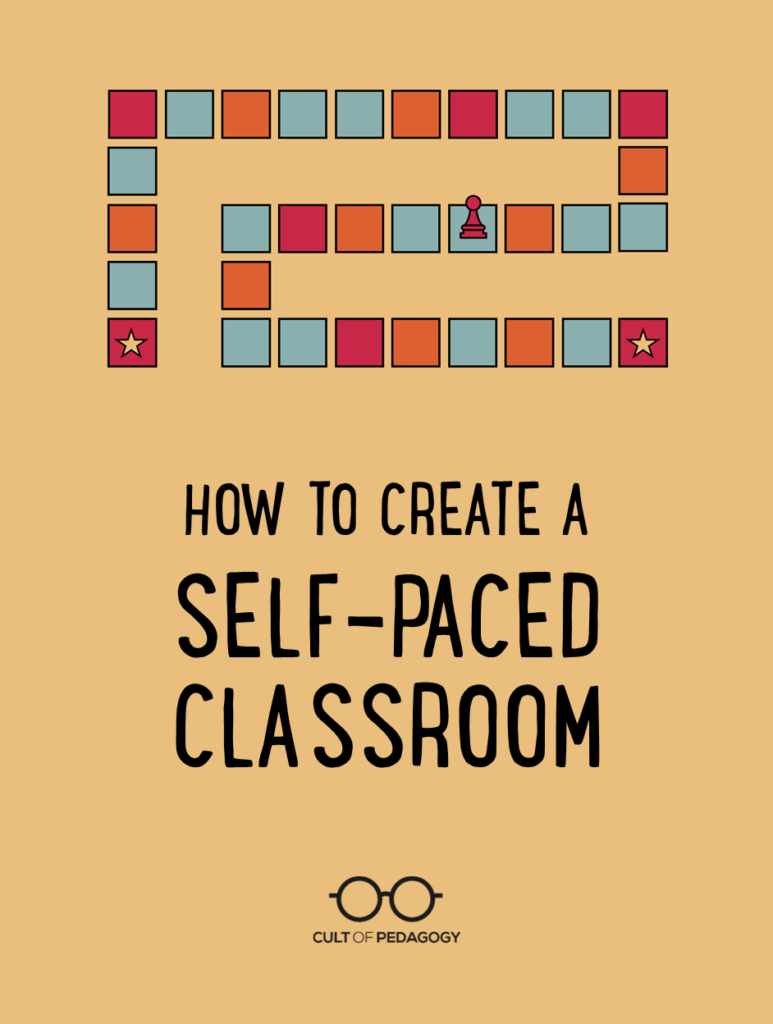
Listen to the interview with Kareem Farah:
Sponsored by Listenwise and Wipebook
As educators, we know our students have different needs. Some fly through our content, while others need more time for ideas to sink in. Some have help at home, while others miss class. Unfortunately, in traditional school settings, the demands of pacing guides and age-based promotion make meeting these needs difficult.
Since the days of the one-room schoolhouse, educators have dreamed of a better system, one where all students have the time they need to achieve true understanding; in other words, a self-paced learning environment. We see examples of self-paced learning in Montessori schools, alternative schools, and cyber schools, but it has yet to reach the mainstream. The one-size-fits-all model churns along, leaving far too many students behind.
Today, I’d like to show you how to infuse self-pacing into your own classroom without lowering expectations for your students or replacing yourself with mindless technology. The blended, self-paced, mastery-based instructional model we built at the Modern Classrooms Project offers a framework for self-paced learning regardless of where and what you teach. If implemented properly, the model can increase the rigor of your students’ learning, enhance human connection and interaction in your classroom, and better prepare your students for success after they leave your class.
While the model I lay out here is undoubtedly at its best in the in-person setting, it has real value for those in remote and hybrid classrooms. With the growing need for productive asynchronous learning time, the timing has never been better for self-paced learning.
Why Self-Pacing?
What do we mean when we say self-pacing? A self-paced classroom is one where students can complete learning tasks at a speed that’s customized to their personal levels of mastery. This means they may take longer with material they struggle with, skip topics that cover material they already know, or repeat topics as needed (Bray & McClaskey, 2010).
The logic of self-pacing is intuitive. Anyone who has raised a child will tell you kids learn how to do things at vastly different speeds. From walking, to talking, to stacking blocks, kids learn differently and we should honor and respect their differences. And research has long demonstrated that students learn at different paces, and the variations in rates of learning are considerable (Davies, 1973; Eurich, 1962).
But for some reason, the large majority of K-12 education has ignored this reality. Instead, we take the opposite stance that students should actually learn at the exact same pace as their peers, and if they can’t keep up, we fail them or push them through the system with no regard for what they have missed. Many of the systems that still dominate much of K-12 education make it difficult for teachers to imagine a world of flexible pacing in their classroom. So before we explore the how, lets dig into some of the reasons self-pacing is so important:
- It builds self-confidence. We all know students who walk into class already thinking they are “bad” at school. They might say they “can’t write” or “can’t do math” or simply “don’t like learning.” We have become accustomed to hearing students express these frustrations, but we don’t spend enough time asking why. The truth is, countless students have spent their whole education career feeling rushed. Instead of giving them more time, we usually give them partial credit and completion grades to push them through the system. Over time, they grow to hate school because they have never experienced the joy of authentic mastery. Self-pacing gives students the opportunity to experience the feeling of true mastery, because they are given enough time and support to get there. For students who haven’t often experienced that joy, it can have profound effects on their confidence.
- It differentiates for students’ needs. Everyone talks about differentiation, but it is extremely difficult to pull off effectively in the classroom. An educator’s capacity to differentiate is fundamentally limited if you aren’t able to modify the speed of learning based on the needs of individual students. There is only so much you can do if every kid has to move on to the next lesson the next day. With self-paced learning, students who understand a skill can move on while you provide appropriate time and scaffolds to students who are struggling to achieve mastery.
- It supports students’ social-emotional needs. When I first started teaching, I felt pulled in two directions. I was constantly trying to balance meeting my students’ unique social-emotional needs with trying to maintain “order” in my classroom. These two priorities often worked against each other. Supporting a student who is struggling emotionally requires time, care and patience: all things that are limited when trying to manage a whole-class lecture or activity. In a self-paced classroom, you no longer have to choose between nurturing an individual student or tending to the larger group; when a student needs your attention, you can provide it without inhibiting the learning of everyone else.
- It supports self-regulation. A critical and often undervalued element of education is teaching kids the 21st-century skills that allow them to become better learners over time. Self-regulation is a uniquely important skill that ensures a student can independently or collaboratively tackle a new challenge in a measured way. Skillfully crafted self-paced classrooms allow students to practice self-regulation, taking partial ownership over the planning and managing of the learning process, which has been correlated with faster learning and higher achievement (Kizilcec, Perez-Sanagusten, & Maldonado, 2017).
- It paves the way for mastery-based grading. The final frontier of our model at the Modern Classrooms Project is mastery-based grading. The goal is to cultivate a learning environment where students progress if and only if they have shown mastery of the previous skill. A hallmark of mastery-based grading is giving students time to revise their work and be reassessed when necessary. To accomplish this, self-pacing is not just valuable, it is essential. You have to be able to let some students move ahead while others wrestle with a skill until they achieve mastery.
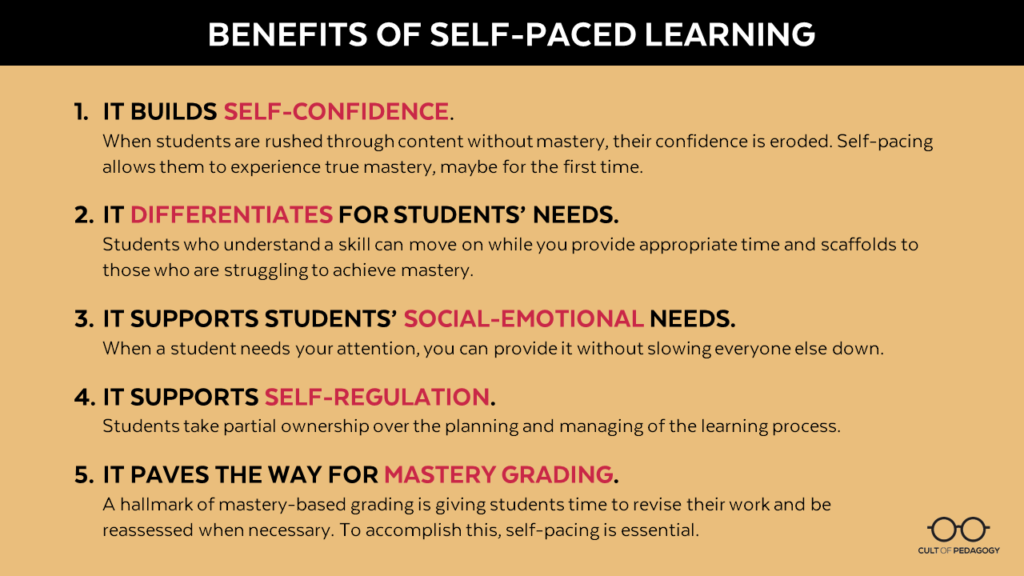
The First Step: Letting Go of Whole-Group Direct Instruction
One of the primary reasons most educators don’t build self-pacing into their classroom is because they are still reliant on whole-group direct instruction. This is not a surprise, given that this is how most educators are trained to teach. But as long as your students depend on you delivering a live lecture or set of instructions at the beginning of class, you’ll never be able to make the leap into self-pacing. So before you consider self-pacing, you have to develop a concrete plan for replacing whole-group direct instruction with lessons students can access on their own.
To be clear, whole-group direct instruction is distinct from whole-group discussions and activities. Any effective self-paced classroom naturally infuses collaborative experiences. I will discuss how this can be done later. But the key is reducing—and ultimately eliminating—those times when kids are simply waiting for you to tell them information so they can get started on a task.
So how do you make this shift? This is where the power of technology comes into play. The most effective way to eliminate whole-group direct instruction is to build your own instructional videos. This ensures that you are still the architect of your own content but allows you to multiply yourself so you are available to spend all of class time working with students individually and in small groups. To learn how to build instructional videos, explore our free online course* or read my previous piece in Cult of Pedagogy that details everything you need to know about building a great screencast video.
How can you self-pace within the constraints of school and district expectations?
The most frequent question we receive at the Modern Classrooms Project is about keeping up with school or district assessment schedules and pacing calendars while running a self-paced classroom. I wondered the exact same thing when I started building my own and have discovered two key strategies to make this happen:
1. Self-Pace Within Each Unit of Study
Self-pacing has real power, but when implemented without guardrails it can present substantial challenges. For example, if you go overboard and let students self-pace for an entire year, you run the risk of having the faster learners fly through content while learners who require more time grow frustrated and lose motivation. This in turn can widen the gap between learners. For this reason, we encourage educators to self-pace within each unit of study, and in many cases, even shorter bursts than that. This gives students the structure they need to flourish and frequent opportunities for fresh starts as they refine their ability to be effective, self-regulated learners.
Self-pacing within each unit of study is not only effective for learners, it also enables educators to follow district- and school-level expectations around pacing. Set your end-of-unit or mid-unit deadlines in accordance with the expectations provided to you, then cultivate a self-paced learning environment within those constraints.
2. Classify Your Lessons
What happens if students don’t master all the lessons in a unit by the deadline? This is the right question to ask and there is research to support that students in a self-paced learning environment might take longer with material they struggle with (Bray & McClaskey, 2010). Therefore, you should expect that some students will be unable to master every lesson before the unit deadline. To navigate this challenge, you will want to classify lessons based on importance, which will empower you to send kids on personalized pathways based on need. At the Modern Classrooms Project, we encourage educators to use the following three lesson classifications:
- Must Do: These lessons cover essential skills and content, without which end-of-unit assessments cannot be completed. These lessons are non-negotiable.
- Should Do: These lessons give students valuable opportunities to develop their skills or knowledge and include skills that are still considered to be “grade level expectations.” However, when students fall behind and are working hard, they can be excused from these lessons and will still be able to transition to the next unit comfortably.
- Aspire to Do: These are the toughest lessons in a unit; they serve as extensions for students who are ready and able to learn skills and content beyond the normal scope of the course. You should feel comfortable excusing kids from mastering these lessons if they run out of time.
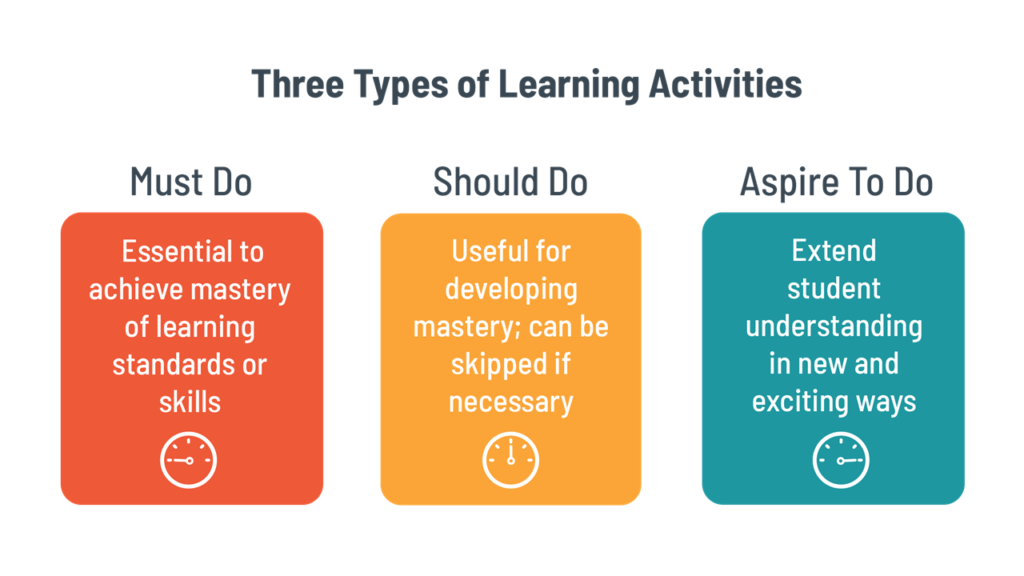
Classifying lessons like these is not an exact science, and there’s no right way to determine what’s essential and what isn’t. However, having clear expectations in mind—a reasonable bar every student must meet during the course, plus extensions for more ambitious students—will help you differentiate your instruction to meet every student’s needs.
Tracking Student Progress
Most educators, including myself, initially feel overwhelmed by the idea of running a self-paced classroom. I was certainly a bit of a control freak who had a tough time imagining a student-centered classroom where kids drove their own pace. In retrospect, my inclination to micromanage the learning environment was limiting my students’ capacity to immerse themselves deeply in the learning process. To soothe my own anxiety and set my students free, I had to create healthy accountability systems to give my students the necessary guardrails to flourish.
In a self-paced classroom, both students and their teacher must know exactly what they will work on every day, constantly tracking progress toward achieving learning goals and mastering content. This helps students get right to work, fosters collaboration, and allows the teacher to provide differentiated support (Lee, 2014; Marzano, Pickering, & Pollack, 2001; Saphier, Haley-Speca, & Gower, 2008). To create the structure necessary for students to flourish, we encourage teachers to build clear progress tracking systems that are easy to update and reward students for effort. We suggest two ways to make this happen:
Public Pacing Trackers
These are publicly displayed in classrooms and indicate where each student is in the unit. In addition to indicating the lesson each student is on, public pacing trackers often highlight the expected pace as well as “lesson all-stars” who have produced exemplary work. It is important to note that public trackers NEVER display grades and given the nature of self-pacing, students have ample time and opportunity to catch up. Also, if lesson classifications are used effectively, the tracker should reflect effort, not ability level.
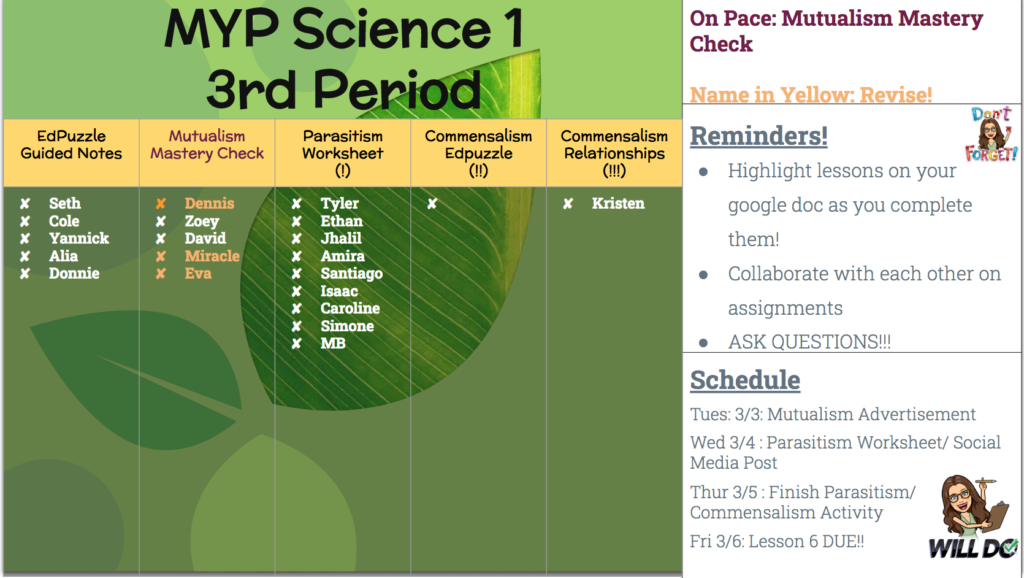
These trackers are usually slide decks or spreadsheets that are easy to update daily. If students don’t want their names displayed, consider using nicknames, ID numbers, or avatars.

Arguably the biggest upside of public trackers is that they encourage organic collaboration. Students can easily identify others who are working on similar lessons or seek out those who have mastered the lesson they are on for support. In some cases, teachers will group students on pacing trackers to facilitate collaboration from the onset. The beauty of the public pacing tracker is that no matter the circumstances, everyone has a VERY clear understanding of what they need to be working on.
Individual Pacing Trackers
Either in addition to or in lieu of public trackers, teachers can create individual pacing trackers for students. These often come in the form of game boards or checklists and are kept in student binders or folders. Educators who use individual trackers will frequently check that students are using them effectively and accurately; sometimes they will label checkpoints indicating when students need to show mastery before moving forward.
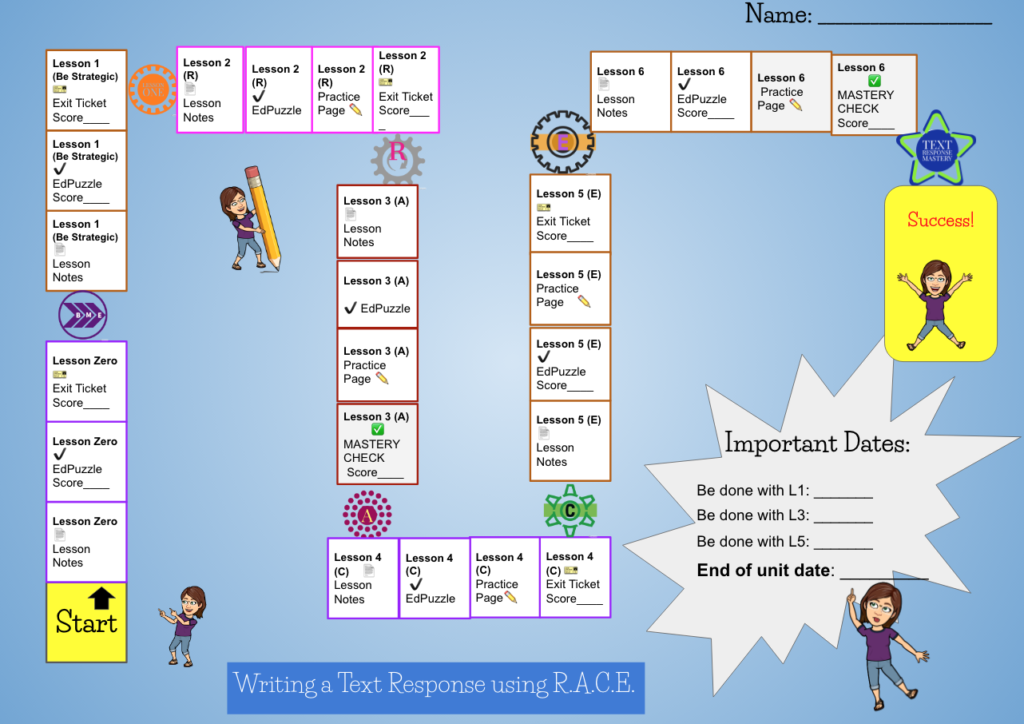
Regardless of which method you use, it is vital to have a method for tracking pace. Otherwise you run the risk of turning a controlled chaos learning environment into a completely chaotic one.
Maintaining a High Level of Collaboration
Too often, folks assume a self-paced classroom is one where students learn in silos, that there is a tradeoff between having a collaborative classroom and a self-paced classroom. But these don’t have to be mutually exclusive. At the Modern Classrooms Project, we see educators naturally build in collaboration through a variety of strategies and techniques. Here are just a few to consider:
Classroom Learning Spaces
Unlike traditional classrooms, self-paced classrooms do not revolve around the teacher delivering content at the front of the room. Therefore, student seating should be designed to encourage collaboration and small group instruction. When students are sitting in groups, they are more likely to collaborate with their peers, either organically or by following their teachers’ guidance. See how one teacher’s daily seating charts foster this collaboration.
Collaborative Tasks and Activities
Whenever possible, educators can design assignments and activities that require students to collaborate to achieve mastery. Here are some examples:
- Consider instituting a policy of “ask three (peers) before me” for classwork, requiring students to reach out to their peers for support before approaching their teacher. You can use student assistance forms to push students to work together and track their collaboration.
- Jigsaw activities built into class practice can foster natural collaboration. For example, half the class completes one aspect of the lesson while the other half focuses on another aspect. Students then teach and learn from classmates who did the opposite assignment.
Whole-Group Discussions and Activities
Most educators who use our model schedule whole-group collaborative activities like labs, Paideia Seminars or discussions throughout their units. Students usually know when these events will happen and what lessons they need to master beforehand in order to fully participate. Many educators will also open each class up with a discussion. The topic can be content-specific or centered around the key 21st century skills they are developing and reinforcing in a student-centered classroom. Remember, whole-group discussions are welcome in a self-paced environment, just not live lectures.
Progress-Based Groupings
One of the beauties of progress trackers is they provide concrete data to support effective collaboration. If a student is struggling on a lesson, they can identify a peer who has already mastered that lesson and approach them for help. In some cases, teachers will use grouped pacing trackers designed to foster collaboration based on the different lessons students are on.
Positive Reinforcement
Most importantly, students will collaborate when they see value in it. Collaboration is at its best when students truly believe they will have a greater chance of achieving their academic goals by working with peers. To reinforce this idea, you can consider nominating “Lesson Superstars” who help their peers understand lessons the Superstars have already mastered. This elevates and praises students who are working hard to build and support a collaborative learning environment.
If you want to dig deeper into the collaborative strategies we have to offer, check out our Guide for Effective Collaboration in a Modern Classroom.
Strategies for Building Student Motivation
Once you have built a well-structured self-paced classroom, it is important to pre-plan motivation strategies that will help keep all students engaged. When students are in the driver’s seat, some will excel, but others may be overwhelmed by the responsibility. This is usually indicative of a need for better self-regulation. Sadly, most K-12 schooling actually conditions kids to be compliant receivers of information. So it shouldn’t surprise you when kids are startled by the sudden responsibility they have when they are able to control their own pace. Some will rise to the occasion immediately; others may initially deflate. That’s ok! All the more reason to use self-paced learning to allow students to strengthen their abilities to be 21st-century learners.
In the same way that we have to scaffold academic content for students, you may have to scaffold self-pacing. Pacing trackers, self-pacing within each unit of study and lesson classifications all help with that process. But one really powerful way to keep students engaged and support their self-esteem is to build in motivation strategies that ensure students believe they can succeed with this newfound level of responsibility. We separate motivation strategies into two groups:
Relationship-Based Strategies
One of the greatest benefits of a self-paced classroom is the freedom you have as an educator to work one-on-one or in small groups with students. This allows you to have deep and meaningful content-related and non-content-related conversations with students without disrupting the larger learning environment. During those times, you can identify what inspires a student and what makes them deflate.
One of the most common strategies teachers use to check in daily with students is through our daily “do now” strategy featured in this 60-second video. Instead of starting class with an academic task, many of our teachers use a “do now” that is designed to get a temperature check on how students are feeling and allows kids to engage in some daily goal setting. This gives teachers instantaneous data on which students are feeling ready to learn and which students might need some additional support or positive reinforcement.
Incentive-Based Strategies
In addition to building strong bonds with students, it is always useful to create incentives that motivate students to stay on pace and excel. Educators use a variety of techniques, many of which look similar to the strategies they may normally use in a traditional fixed-paced setting. But some of the most effectives strategies leverage the power of self-pacing to motivate students. For example, a number of teachers will use “aspire to do” as a compelling strategy to get kids fired up about mastering content. For kids that are eager to succeed, they will feel compelled to master content beyond the scope of the unit.
In some cases, students need to see the downside of wasting time before they realize that too much procrastination is dangerous. That is why many of our teachers will use a “soft-zero” grading policy by entering “0” grades as placeholders for must-do lessons. These “0s” are temporary as long as the student eventually masters the skill. But it emphasizes the importance of mastering must-do lessons and gives students a grade-based reason to catch up. If you use this strategy, it is critical to reinforce to students that they can always catch up and celebrate them when they do!!
Where to Go to Learn More
Running a self-paced classroom is not easy. The strategies outlined above require careful planning, and implementing them effectively with actual students requires constant reflection, refinement, and commitment. With that said, both I and the teachers whom I’ve trained through the Modern Classrooms Project would wholeheartedly agree that the benefits—for both students and teachers—more than justify the challenges.
If you’re interested in launching a self-paced classroom of your own, I’d strongly encourage you to start with our free online course*, a comprehensive overview of our instructional model, complete with exemplar units, templates, and other useful resources. We’ve heard from teachers nationwide who have completed this course, taken the plunge into self-paced learning, and marveled at the results. You can read many of their stories in our public Facebook Group.
Finally, if you’d like the support of an expert in building your self-paced classroom, consider enrolling in our Modern Classroom Mentorship Program. Our mentors are all teachers whom we’ve trained in our practices, and whom we’ve seen implement our model across a wide range of subject areas and grade levels. As part of the Mentorship Program, you’ll be paired with a mentor and receive `1-on-1 coaching, feedback on instructional materials and plans you create, and ongoing support from the broader Modern Classrooms community. Most importantly, you’ll leave the program ready to launch a self-paced learning environment of your own. If you’re interested in enrolling, you can save $50 at any time with the coupon code CULTOFPEDAGOGY.
Whether you stop after reading this article, take our free course, or enroll in our Mentorship Program, I wish you the best of luck on your Modern Classroom journey. Your students, and our world, require nothing less!
* Cult of Pedagogy has an affiliate relationship with the Modern Classrooms Project. Although the Modern Classroom Essentials course is free, if you purchase one of their paid offerings through the links on this post, Cult of Pedagogy will receive a percentage of the sale at no extra cost to you.
References
Bray, B., & McClaskey, K. (2010). Personalization vs. differentiation vs. individualization. Mid-Pacific Institute, 1(1).
Eurich, A.C. (1962). Technology in education. New Society, 11, 15-16.
Kizilcec, R. F., Pérez-Sanagustín, M., & Maldonado, J. J. (2017). Self-regulated learning strategies predict learner behavior and goal attainment in Massive Open Online Courses. Computers & Education, 104, 18-33.
Lee, D. (2014). How to personalize learning in K-12 schools: Five essential design features. Educational Technology, 54(3), 12-17.
Marzano, R.J., Pickering, D.J., & Pollack, J.E. (2001). Classroom instruction that works: Research-based strategies for increasing student achievement. Alexandria, VA: ASCD and McREL.
Saphier, J., Haley-Speca, M.A., & Gower, R. (2008). The skillful teacher: Building your teaching skills. Acton, MA: Research for Better Teaching, Inc.
Join our mailing list and get weekly tips, tools, and inspiration that will make your teaching more effective and fun. You’ll get access to our members-only library of free downloads, including 20 Ways to Cut Your Grading Time in Half, the e-booklet that has helped thousands of teachers save time on grading. Over 50,000 teachers have already joined—come on in.





I think possibly these articles are written by teachers who have not been in the classroom for several years and are most certainly not teaching currently. Left out of this equation are the large percentage of students who do not value their educational journey. I spend so much time on student motivation and showing them the incredible value and opportunities education will offer them. Every one has a quick fix or “blog” for remedies, except motivation. And please, don’t start in the “caring” and “engaging.” I have killed myself for 15 years in those two arenas with little results. I am beginning to leave those behind who aren’t willing to make the effort.
I feel you Debi! I do think i want to use method expressly for this reason. IF you only want to do the bare minimum that option is built in. We can’t save everyone right?
Debi,
It seems that I am a little late to the commenting party. However, I think that if it’s your plan to “leave those behind who aren’t willing to make the effort” then it is time for you to retire. There has been research for decades saying how the education system needs to be reformed and that mental health is on the decline. Why must people fight change if we know that change is what’s needed? You can’t possibly begin to understand these student’s lives outside of your classroom. Maybe one student is working a part time job to support their family, so right now school doesn’t seem all that important. Or maybe another one is dealing with the divorce of their parents and can’t concentrate on school. This job IS exhausting, in every definition of the word. But, teachers are the last line for defense for these kids. When it seems like the world has given up on them, the teachers need to support them EVEN MORE, not less. I hope you have either had a change of heart or a change of careers because this mindset is not healthy for anyone, let alone the students or yourself.
I taught Science for 8 years in an at-risk alternative high school and everything was self-paced. I wish I’d known some of these strategies back then! I am especially impressed with “do now” and the public pacing trackers to encourage collaboration.
Thank you Kareem & Jennifer for helping so many teachers learn about and implement self-paced learning that will benefit all students.
BrP
Okay, I am blown away by the prospect of making my classroom a self-paced classroom. I flipped my math classes last year, which is similar to this. Flipping my classes had an immediate and positive effect on the students who had struggled historically, but I was disappointed that I still had students who were not being challenged enough. This could be the solution.
I like that the students work at their own pace, I love that there can be student-to-student mentoring opportunities, and I appreciate that students will simply have to take responsibility for their own education, though I concede some won’t take to that right away (and some maybe never). I love being able to flit about the room and deeply engage with students as needed too. That was something that really worked for everyone in my flipped classes last year.
I chuckled a little as I was reading through the article, because just as a question would pop into my head, like “what about group work? Group work is so important” – then, bam! the next paragraph was on how to incorporate group work; and “how would I ever track this?” – the next paragraph had everything I needed to know about tracking student learning. All my questions were answered.
The only obstacle I have left is actually making engaging video lessons and categorizing tasks as must do, should do…etc. Ideally this would be implemented by a whole school or a whole department so teachers can collaborate on that – and on the videos.
Thanks for sharing this, Johanna. If you have already, check out Everything You Need to Know About Building a Great Screencast Video. You might come across some helpful tips.
I learned about The Grid Method last spring, then the Modern Classrooms Project more recently. Along with hyperdocs, they have helped me reshape my teaching for being remote and hybrid. I’m still trying to figure out the pacing, but I think it’s very, very solid.
Grade 7, 20+ years of teaching SS
Kerri,
I just discovered The Grid Method and Modern Classrooms Project. I am now wondering how they could work together. I teach MS math but any suggestions would be much appreciated! Thanks!
Thank you for this. I’ve been looking for a way to make the current crisis we’re wading through turn into an opportunity and I think this is it. I knew I was onto something with this article when I stopped reading to start jotting down ideas about how to turn my courses into something like this.
I empathise with the above comment because I know this would be much harder if I were teaching in the US or in a more regimented kind of school but for me it might just work.
Thank you.
Thank you for valuing asynchronous learning. Expecting everyone to be learning the same thing at the same time limits students who are ready to move forward. I am a teacher of the gifted and I love Khan Academy for student-centered, self paced learning. Students get immediate feedback, student demonstrate mastery and they are motivated to move forward. The KA tracking system is detailed, it allows student choice and is available for teachers and students. Let’s facilitate academic freedoms for students, let’s democratize education and provide every student with the opportunity to reach their full potential.
I love this! I was a self-paced teacher back in 2012 teaching 8th-grade math. I absolutely loved the experience, so much so that I have presented on it numerous times…including to Ms. Bray and Ms. McClaskey! 🙂 I love the new ways that technology has improved the experience since those days. I have a Prezi from back in the day when it was a relatively new concept and I was presenting at conferences: https://prezi.com/t06rlxuqulho/
Thanks for sharing, Jessica!
Do you have anyone who has successfully implemented this in elementary school, grade 5?
Thank you for this! I took this week off because I was so burnt out I thought I might just resign if I didn’t. I didn’t want to think about teaching at all but while I was gardening and my hands were dirty, your latest podcast came on. I listened all the way through and I am doing the free PD right now. Thank you! I really wasn’t sure how I was going to go back in the classroom next week but now I have some new skills that I am going to start planning for and I feel renewed.
Jenna, I’m so glad to hear that this post was helpful and inspiring – it breaks my heart though to hear how hard things have been. I’ll be sure to share your feedback with Jenn!
I totally see this for a math class, but can’t wrap my head around how it would work for an ELA class when reading a class novel for example.
Hi Josie,
Take a look at Using Playlists to Differentiate Instruction – this post, with Tracy Enos, shares examples of ELA playlists for a self-paced classroom. And if you aren’t already familiar with hyperdocs, check out How HyperDocs Can Transform Your Teaching. Hope this helps!
In theory I like the idea… I dont see how its feasible to monitor 80 plus student trackers? And I dont need kids comparing each other on one tracker. I teach middle school math. How many pieces of work are you evaluating per unit to identify level of mastery? Are you giving time to go back for mastery? It’s also challenging to jigsaw a discussion when kids are at very different steps.. also doesn’t half the class become mentors without having anyone to mentor them (really does not work unless you have a 3 grade level group.. that shifts every three years). Are all the kids doing the same work? Worksheets? Responses.. how do you give answers without giving access to all students? I do revisions, soft zeros, gc feedback etc. Are there any team projects? There is mentoring collab then there is team collaboration. How is team collab facilitated when you have students far behind vs those way ahead? Are you creating a rubric for each piece of the work? I get the premise.. I am unsure of efficient application in the general overloaded isolated middle school classroom that has to log grades.
Hi Suz,
You ask a variety of good questions. All questions we asked and explored as we rolled out the model in our classroom. They span a wide variety of topics that are featured separately in our free course. My suggestion would be to start there (learn.modernclassrooms.org).
More importantly, I would keep in mind that every teacher makes this model their own. So some quick responses to your questions:
1. How many pieces of work are you evaluating per unit to identify level of mastery?
Answer: This is 100% up to the educator and depends on the grade level and content area.
Are you giving time to go back for mastery?
Answer: Of course, in fact that is the point of the model and self-paced learning. Kids are constantly revising their work.
Are all the kids doing the same work? Worksheets? Responses.. how do you give answers without giving access to all students?
Answer: I am not entirely sure what “same work” means in this context. Generally the tasks are the same. There is differentiation based on the lesson classifications. There are accommodations and modifications based on students’ needs. There are plenty of ways to share answers as long as you keep the mastery check answers private and built a culture of academic integrity.
Are there any team projects? There is mentoring collab then there is team collaboration. How is team collab facilitated when you have students far behind vs those way ahead?
Answer: There is tons of collaboration of all forms. Some teachers do team projects, some focus on organic collaboration and some focus on planning collaborative session ahead of time. Students are already “way behind” their peers with regards to mastery in most classrooms around the country. Having them be on the same lesson doesn’t mean they aren’t behind. Collaboration isn’t contingent on kids being at the same level unless you design it that way.
Are you creating a rubric for each piece of the work?
Answer: This is 100% up to the educator. I wouldn’t feel the need to do this for anything other than large assignments/project and mastery checks.
Great book not only to read, but motivated to inspire kids in their process of learning
I teach 4 preps of foreign language and would love to be able to implement but it sounds like it would become 6 or 7 preps – how could I make this sustainable in my efforts? I think I’d be really burnt out.
Hi Erica,
I would roll this out one/two preps at a time. Redesigning you classroom around this model takes time but is long lasting. Once you build it out in one prep, it will be re-used and refined over time. So the work you will be doing will pay dividends!
Best,
Kareem
How do you create a spreadsheet that is pictured under public pacing trackers?
https://x78251kcpll2l2t9e46kf96a-wpengine.netdna-ssl.com/wp-content/uploads/2020/11/Spreadsheet.png
Hi Daria,
We’ve reached out to Kareem and hopefully he’ll be able to help you out when he has a moment. In the meantime, I’d think you could just create something that works for you using Google Sheets.
Kareem,
Thank you for sharing your work with the Modern Classroom Projects initiative. I have long been an advocate of developing self-regulated learners as I think schools are often guilty of creating learned helplessness so that element of your approach definitely resonated with me. While we talk a great deal about the importance of differentiated instruction, I seldom see such an intentional, comprehensive approach as the one you have provided. After 30 years in the classroom, I moved into administration (although I still teach) so my lens on implementing programs such as a self-paced classroom has changed.
I am at a very traditional Canadian school that prides itself on preparing all its graduates for university. As such, there is always an underlying pressure, largely from the parent community, to have students attain the necessary grades and this can come at the cost of their desire to learn. Our research shows we have a high percentage of students who are “doing school” as we are simply a stepping stone to a university program. This then leads to teachers who fixate on covering the curriculum as opposed to meeting the needs of a diverse student population.
With that lengthy preamble complete, I really have two questions for you: 1) How did you deal with the inevitable change management piece when you implemented the Modern Classroom Project, and 2) How did you gain parent buy-in?
I am going to look more closely at your online course, but I would love any advice you can provide.
Richard
I love this idea. I think i could slowly incorporate this into my classroom.
I think it would be a great way to help kids learn at their own pace.
I would be a little overwhelmed on how to do this in a elementary classroom.
What are the benefits of doing the instructional videos instead of lecturing in front of the class?
Hi Garrett,
The main benefit is that it helps you move toward self-paced learning. Over on the post, Kareem talks about this in a section called The First Step: Letting Go of Whole-Group Direct Instruction. See if this helps, but if there’s something more that you’re looking for, let us know. Thanks!
I teach 6th grade in the middle school. My concerned is this: Can 6th graders benefit with this type of method with instructional videos instead of the teacher lecturing? What if you have those students that don’t like the idea? I’m going to do a trial run when school starts to see what the students think (will do a survey to get feedback).
Ahhhh, I get it. First, yes, give it a try. Remember that this may be very new to a lot of kids and they’ll need time and practice with being more self-directed. Some kids may not be ready – take a look at this article for alternatives. Playlists and hyperdocs are other self-paced strategies to consider.
And if you haven’t already, be sure to check out tips for making great screencast videos and slideshows.
Good luck and have fun!
I found this podcast and resource useful. Most teachers who have flipped their classes before will find that the idea behind Modern Classroom is very similar, so is not really new, but their system is well structured and there is a big community out there. Anything to help teachers present and prepare better lessons is helpful.
Similar to differentiated instruction for special education students.
This podcast and resource was very useful.
So glad you’ve found them valuable, Martha!
I’ve been doing self-paced lessons since 2016. I didn’t know about Modern Classroom as a resource. When remote learning hit, I felt as if my classroom was well prepared to handle the challenges that came about. Since returning to in-person learning it has felt as if there is serious pushback from students and administrators to the self-paced classroom. They say that it is identical to remote learning and that remote learning failed students so we need to rethink using this method. Because of this pushback I was starting to doubt the effectiveness of a self-paced classroom. Finding this episode of the podcast and being introduced to the resources from Modern Classroom have reignited my belief that a self-paced environment IS the best way for my students to learn. Thank you for the increased confidence to keep doing what is best for students.
So glad the post was helpful for you, Adam!
In my project-based business technology class, self-paced learning has its advantages and disadvantages. Students working on difficult software projects or complex entrepreneurial projects would benefit from self-pacing.
I still foresee problems with student involvement (apathy) and classroom management even with this method allowing advanced learners to access more sophisticated skills while others focus on basic concepts.
Another area of concern arises from IEP modifications in a self-paced program. While scaffolding is necessary, it may contradict the principles of self-pacing.
Summer,
It’s true that some of our students struggle with executive functioning and self-regulation, whether in a traditional setting, a PBL-based classroom, or in a self-paced learning environment. However, like the article mentions, there are still ways to differentiate so that the instruction is delivered effectively. Students typically enjoy high levels of engagement when the material is a) appropriately challenging, b) appropriately paced, and c) relevant. Teachers who focus on those three elements typically have fewer management issues which leaves more time to help students who are not moving quickly enough through the material for whatever reason. With trial and error it’s possible to find a mix of teacher-directed and self-paced instruction that blends the best of both worlds! Best of luck to you on this journey!